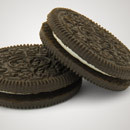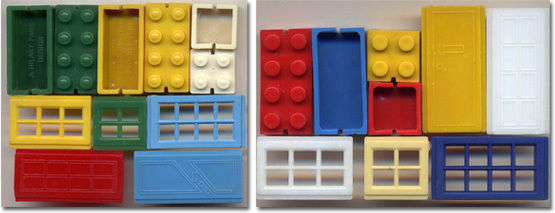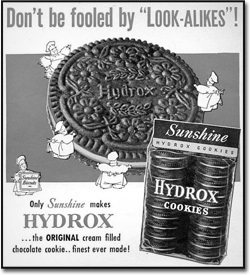5 World-Famous Products That Are Shameless Rip-Offs

You know a product or brand has become a big deal when cheap, generic knockoffs start showing up everywhere: Transformers had Go-Bots, Bruce Springsteen had John Mellencamp and Mad magazine had Cra ... um, you get the idea. However, it turns out that many of the "knockoff" brands we've scoffed at in the supermarket were there before the more famous, million-dollar "original" product ... that totally stole their idea. Like ...
LEGO Copied Its Big Idea from Kiddicraft Blocks

LEGO building blocks are one of the best known toy lines in the world, and for good reason. There's something for everyone -- kids who are into building stuff can create their own elaborate play sets, and kids who are into breaking shit down can do so without rendering their toys unusable.
It's such a simple yet genius idea, you can't help but wonder how the guys who started the company came up with it -- or rather, how they came up with it before anyone else.
Hint: They didn't.
But They Copied It From ...

Kiddicraft: The original child-choking block.
Those are not LEGO blocks: Those are Kiddicraft's "self-locking building bricks," created 10 years before LEGO "invented" the same thing. This is what LEGO was doing at the time:

Somehow, we don't see Wooden Duck Batman or Star Wars making a fun video game.
In 1939, child psychologist, author and pioneer toymaker Hilary Fisher Page developed a visionary new toy: hollow, plastic building blocks with four or eight studs that enabled children to build stuff with them, from little toy houses to huge plastic skyscrapers. Page himself built these structures for Kiddicraft's stand at the 1947 Earls Court Toy Fair. You know those impressive LEGO displays of entire cities they have in their parks and stores? Kiddicraft was doing that before LEGO bricks even existed. Here's a picture of some Kiddicraft buildings:

You could also build extremely realistic-looking toddlers.
In the same year, LEGO's founder Ole Kirk Christiansen bought a plastic injection machine from a salesman who demonstrated the type of toys that could be produced with it by showing him some Kiddicraft play sets. This was only meant to be an example of the machine's capabilities, but Christiansen had a better idea: doing the exact same thing and calling it by another name.
LEGO went into full Thomas Edison mode, copying the Kiddicraft play sets right down to the little doors and windows that came with them:

Kiddicraft on the left, LEGO on the right.
The rest, of course, is history. LEGO went on to become a household name to such an extent that it is now impossible to go to the bathroom in the middle of the night without stepping on at least one of their products on the way (even if there are no children in your house). Page, in turn, ended up committing suicide in 1957 as his company went down the toilet. LEGO respected his death by gleefully buying the rights to the rest of his ideas in the '80s, then doing nothing with them.
Oreos Ripped Off Hydrox, Not the Other Way Around

Nabisco's Oreos are so popular that the name itself is by now practically synonymous with sandwich cookies, to the point where many of you probably didn't even realize "sandwich cookies" was a term until you read it just now (we all just call them Oreos, like aspirin or thermos). Oreos are so ingrained in American culture that we even have special gadgets for dunking them in milk, but they're also eaten and enjoyed all over the world.

And some parts of Mars, apparently.
But They Copied It From ...

Yep, Hydrox -- otherwise known as "Sorry, Billy, they didn't have real Oreos at the store" -- is the true and original sandwich cookie. Oreos have been the knockoff brand all along.
Hydrox cookies made their first appearance in 1908 as the signature product of a small company called Sunshine Biscuits. They were greeted by the public with open arms and single-handedly ruled the sandwich cookie market for four years ... until they noticed the giant food company peeking interestedly over their shoulder.

"You'll never leave us, right, obese miniature cooks? Not like those elf bastards ..."
National Biscuit, the massive company that would later become Nabisco, took an interest in this strange new product that seemed to cause raging cookie boners everywhere it was sold, and created their own ripoff version, using their vastly superior, already established distribution channels and massive advertising budgets to tear through the country with it. Sunshine, despite being a nascent little company, didn't take this offense lying down -- for a long time, their whole marketing strategy consisted of saying "Um, guys, we were here first, remember?"

"I'll put a cookie through your goddamn eye if you don't believe me!"
Eventually, however, they had to stop doing that because it simply wasn't believable: Oreos became so popular that Hydrox started being perceived as the imitation, and any claim to the opposite would be met with an indignant "Shyeah, right" from the public. It probably didn't help that their chosen brand name would be more appropriate for cleaning products or '90s comic book villains.
Nabisco's marketing machinery steamrolled all over Hydrox so badly that Sunshine was eventually bought by other companies and their products discontinued, while that filthy imitation product known as "Oreo" went on to become a cultural icon. And just in case you think this kind of thing doesn't happen anymore, here's a more recent example ...
The ShamWow Guy Stole His Product (and Style) from Billy Mays

You've seen it on TV a million times, and maybe you've even considered buying it: ShamWow is the super-absorbent towel featured in one of the most popular infomercials ever made. It's all the work of Offer Shlomi, best known as Vince Offer, even bester known as simply "the ShamWow Guy."

Also as "The Great Cornholio" ... who's apparently moved on from TP.
Love or hate his annoying, hooker-punching guts, you have to admit that it takes real talent to turn a glorified cleaning rag with "sham" in its name into one of the best-selling "As Seen on TV" sensations ever.
But They Ripped It Off From ...

ShamWow is a blatant ripoff of the equally ridiculous-sounding Zorbeez, which came out two years earlier and was sold by the third biggest celebrity death of late June 2009: TV pitchman Billy Mays.
But, big deal, right? The technology has existed for decades, and numerous products had used it before. These guys just found a more creative way to sell it. Or Mays did, anyway, because it turns out that Offer completely stole his pitching style. Check out this comparison between the two infomercials:
It's the exact same selling style, right from the "Hi, it's (name) with (product)" greeting at the start ...

... to the part where they press the towel in a glass bowl with both hands while bragging about how much liquid it holds ...

... which is followed by the towel being thrown into a washing machine ...

"Hold off on the rest of that laundry. I have to wash this single hand towel first."
... and someone pouring soda on a patch of carpet while telling you it also cleans wine and coffee, in that exact order.

They then clean the cola by pressing the towel on the patch of carpet ...

... before reminding you of exactly how much you spend on paper towels in a week.

This guy may be slightly above the average.
Upon seeing the infomercial, Mays got so furious that he decided to handle the situation like a WWE wrestler -- here's Mays calling Offer out in a radio interview, dismissing ShamWow as a clear knockoff, dubbing himself the Ultimate Pitchman and challenging Offer to a "pitch-off," which we can only assume is infomercial slang for a cage match.
Perhaps wisely, Offer chose to avoid his legitimately pissed-off, bear-sized opponent. Instead, he waltzed off to "invent" a kitchen utensil called Slap Chop ... and started marketing that by taking potshots at Quick Chop, an earlier, identical product also sold by Mays. There's just no honor between shameless product peddlers anymore.
Skechers Turns Charity into a Pissing Contest With a Knockoff Shoe

Skechers is the largest shoe company in the world, which many of you might equate with "the largest employer of whipped Vietnamese children," but we have to give them credit for trying to do things right. Take their BOBS line of shoes, introduced in 2010: They're not only comfortable, affordable footwear designed in the style of South American espadrilles, but they're in fact specifically meant to do good. They're ethically produced in developing countries, and Skechers actually donates one pair to children in need for every pair they sell.

But They Copied It From ...

Nope, that's not the same shoe from another angle -- if you look carefully, you'll notice it says TOMS instead of BOBS. Big difference, because TOMS isn't run by total douchebags.
It turns out that Skechers copied the whole BOBS thing from TOMS, the smaller company that introduced the "one-for-one" charity concept four years earlier. So, OK, now we have two companies giving away shoes to poor children, and we'd have to be jerks to complain about that ... except that it wasn't just the good deed Skechers copied, it was the entire TOMS business model.
BOBS seems specifically designed to drive TOMS out of business -- they're both based on the Argentine espadrille, they're both male names in all caps and, on top of that, Skechers initially priced BOBS two dollars cheaper than TOMS. The whole thing was capped off with a massive launch campaign that promised to donate not one, but two pairs for each purchased pair of BOBS.

The children were crushed when they realized it was "pair of BOBS" with one O.
Hell, even their slogan is "Inspired by the good deeds of others." If that was really the intent, why not start donating some of their existing products? Instead, Skechers seemed to go out of its way to turn a charity model into a pissing contest. There's no logical reason why they had to copy every single thing about TOMS, except for planting themselves as their direct competition. Look at it this way: Every BOBS espadrille shoe sold is one TOMS didn't sell.
While neither company gives out sales figures for their goodwill shoes, it's pretty safe to say that the $1.4 billion per year Skechers walked all over TOMS (their total sales since 2006 are around $44 million). If they were honestly trying not to be evil here, they're doing a pretty shitty job at it.
Pixar's Finding Nemo Suspiciously Resembles a Children's Book

Finding Nemo, the story of a clownfish looking for his lost relative with the help of other sea creatures, is still one of the most beloved, critically acclaimed and commercially successful animated films of all time. If you've never seen the DVD before, then you simply haven't been around children in the past ten years or so.

And we hope it's not because of a court order.
It is also a Pixar movie. You can probably guess where this is going.
But They Ripped It Off From ...

Pierrot: The Poison Clown sounds way more badass than Finding Nemo.
If you saw that cover in a bookstore, you'd probably assume it was some cheap picture book quickly thrown together by someone hoping to cash in on a Disney movie and not-too-observant parents. That's exactly what French bookstores thought and the reason why they stopped stocking this book when Finding Nemo was released in 2003 ... even though it actually predates the movie. And, according to the book's author, the resemblance isn't a coincidence.
In 1995, a French children's author called Franck Le Calvez wrote a screenplay called Pierrot the Clownfish -- he envisioned it as an animated film and indeed managed to sneak it into the hands of some filmmakers. Unfortunately, no one was interested in developing the idea, so eventually Le Calvez dug into his savings and self-published the story as an illustrated children's book in 2002. At least that way he could get his story out to people, and hey, maybe some movie studio would like it and turn it into a film. Imagine the brick he shat a year later, when a film did come out and made millions of dollars, except his name was nowhere to be found.
Although the makers of Finding Nemo say they never saw the screenplay for Pierrot the Clownfish, there is a strange similarity between both works. Let's compare: Both Nemo and Pierrot are clownfish living in an anemone ...

Oddly enough, the book described Pierrot's dad as "kinda sounding like Albert Brooks, only more European."
Both titular characters lose a parent to a predator (Pierrot's father and Nemo's mother) and get separated from the remaining one, and the plot of the story is about them reuniting. Although the focus of Finding Nemo at this point shifts to Nemo's father, Marlin, the similarities keep on piling up. Marlin/Pierrot both meet a surgeon fish during their journey (Finding Nemo's Dory), along with other underwater characters, including a cleaner shrimp.

Who, even in the Pixar version, is extremely French.
Le Calvez took his case to court, where Disney lawyers unsurprisingly ate the author for breakfast. At the end, the judge decided in Disney's favor with the reasonable justification that Pierrot and Nemo are completely different characters because they were a different shade of orange.
Pauli Poisuo blogs at Year of the Fat Bastard and tweets when he remembers.
For more crappy knockoffs, check out The 15 Most Unintentionally Hilarious Bootleg Toys. Or discover 6 One-of-a-Kind Things You Won't Believe Had Duplicates.
If you're pressed for time and just looking for a quick fix, then check out 4 Buildings That Defy the Laws of Gravity
And stop by LinkSTORM to see who wears BOBS and eats Hydrox in the office.
And don't forget to follow us on Facebook, Twitter, and Tumblr to get sexy, sexy jokes sent straight to your news feed. Are you on Google+? So are we!
Do you have an idea in mind that would make a great article? Then sign up for our writers workshop! Do you possess expert skills in image creation and manipulation? Mediocre? Even rudimentary? Are you frightened by MS Paint and simply have a funny idea? You can create an infographic and you could be on the front page of Cracked.com tomorrow!